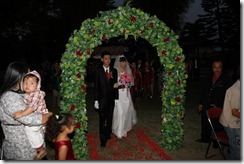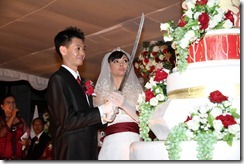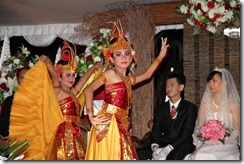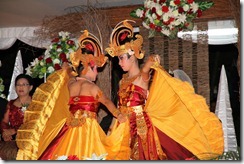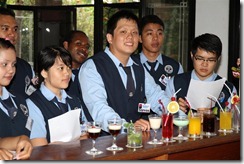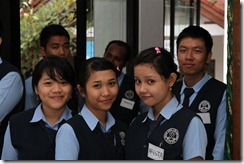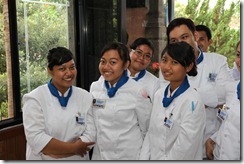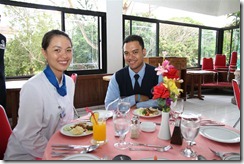Last year I visited several GKPB churches, but this year I’ve only worshipped at two. The “Yudea” congregation less than a 10 minute walk from the campus is definitely the closest, but the service is (not surprisingly) in Indonesian. I prefer to take a taxi to Seminyak where I worship with the English speaking congregation at Sto Mikael, at the entrance to the Dhyana Pura Beach Resort Hotel.
 |
| Sto Mikael Church, Seminyak |
 |
| The illuminated church is an unexpected sight by night |
The early morning and evening congregations are for local folk. The 10 am service is for a few English speaking local people, temporary residents, longer term visitors, and guests from some of the nearby hotels. The building is intriguing, as it looks like no other GKPB church. The church buildings usually follow traditional Balinese architectural styles. Sto Mikael looks, as you can see, like something lifted from Europe. It is actually a business venture for a company which provides wedding packages for mainly Japanese couples who want a European style wedding – wooden pulpit, stained glass windows and all. The local church gets the use of the building, and this also makes it “a real church”, not just a wedding hall. The worship leaders have been very hospitable and made me feel at home there.
 |
| Elder Pica Turker welcomes folk to Sto Mikael |
After church I often walk along Seminyak beach, south towards Legian, but rarely as far as Kuta – a place which holds little attraction for me. Sometimes there are few people, but on this day the beach was crowded. Visitors were roasting themselves on hired deck chairs (I saw some impressive cases of developing sunburn) and some were surrounded by up to 4 massage ladies – one for each limb. Hawkers and vendors moved amongst the chairs and umbrellas trying to sell ice-creams, fruit, kites, watches, decorative knife sets, sunglasses, paintings – it if it was small and portable someone was trying to sell it.
 |
| Hawkers find a target. |
 |
| A beachside massage from one of the many elderly massage ladies |
 |
| The bankers take to the beach for fun and fundraising |
In one area there were many people wearing “Bankers Against AIDS” T-shirts. A banking group was having a beach day with surfing lessons, beach activities, lunch and so on. Surfing schools were instructing visitors, and photographers with long lenses were capturing their early efforts in the hope of selling photos to the surfers. Boys were flying kites, and men were selling kites. It was a busy beach, and the surf was reasonable.
 |
| One of the many types of novelty kites on sale on the beach. |
 |
| A surfing instructor demonstrates stance to learners |
 |
| Another group of learners takes to the water |
Although Kuta’s original attraction was the wide beach and surf, on most days I’ve been here the surf has been quite poor. The beach impresses many of the Europeans and those used to rocky coastlines, but I prefer the best of the Australian beaches. As many of the large stormwater drains discharge across the beach to the sea, the beach and waters can be left in a foul state after heavy rains. There has been no rain this year so far, but last year I saw the beaches covered with greasy slicks and littered with plastic bags and all sorts of rubbish. It is a big problem across Bali, and although the “Keep Bali Clean and Green” message is growing, there is a huge job ahead to change public behaviour, especially when rubbish collection services are so limited. “Put it in a bin” is a good start, but unless the bin is emptied and rubbish collected, eventually the bin fills and contents spill out (or someone burns it to make more room).
The main stretches of beach north from Kuta are patrolled by the surf lifesaving group, the Balawista. They have interesting club houses along the coast with their graphic logo depicting a hand jutting up from the waves. It is a very good visual message!
The grounds of the Dhyana Pura were almost deserted 2 weeks ago. The bright sun had brought many guests to the pool and surrounds but few had ventured in to the beachside cafe. There I had lunch with Jim Speelman, the coordinator of the visits by Dutch students for their semester of intensive English, Indonesian and business studies at Dhyana Pura Campus. The bumbu grilled fish was delicious but the bumbu (“spiced”) was just a bit too bumbu after my walk. The chili was so strong that I had to remove the loose “topping” and after that the taste was about right.
From Hotel Dhyana Pura I returned to Campus Dhyana Pura where preparing 4 sets of lessons for classes on Monday kept me up until late. From early Friday afternoon until Sunday night I’d had quite a full schedule. The new week sould start with lessons at 7:30.
Paul in Bali
September 2011







